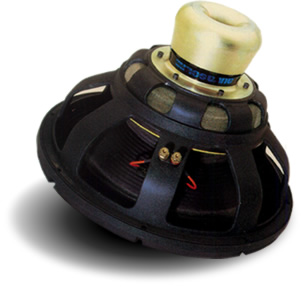|
Let start from the largest drivers and go down. There are larger then 18” drivers (23” and 30”) but looking at this magnet structures I do not find them serious. I addition to make the 23” cone stiff enough requires a lot of diaphragm’s mass or to use very “bad for sound” materials.
The 18” driver would certainly be a woofer. If 18” driver used above 60Hz then it is misused. To my knowledge there was only one exceptional 18” driver even made… or perhaps it was a small family of the drivers that pretty much derive from one father: the AuraSound 1808 driver.
Aura made their 1808 driver in 80s and most of the 90s and it was wonderful. It had huge high-temperature neodymium magnet, unique magnet geometry with underhung 4" edgewound aluminum voice coil. It was the only 18-inchers underhand voice coil ever produced. The finny part that despite of the underhand configuration it had 98dB sensitivity with 2” total excursion – what a motor! The driver had paper cone, cloth suspension and had phenomenal articulation at lowest frequencies. The 1808 was suggested for 20 Hz - 200Hz but it did not sound good even at 80Hz. The Aura 1808 had free air resonance at 24Hz and required enormous sealed enclosure of 14-16 cu feet. Wilson Audio used the Aura 1808 in their unfortunately-ported XS subwoofers and soaked from their relatively small enclosure an extra 19dB of port noise at 20Hz.
The mid of the 90s was great time for the “exceptional 18” driver”. If you do not like the large boxes of the Aura 1808 (that in reality had Fs from 24Hz to 28Hz) then you could get form North Creek Music their version of Aura 1808. They call it Leviathan and it was a next step into the wonder of the Aura’s motor. George Short (the North Creek Music’s guy) took the Aura 1808 and changed the cone’s suspension, effectively dropping the free air resonance down to 11Hz-13Hz. Now it was possible to use this driver in 5-6 cub feet sealed enclosure and get out of it an amassing bass in context or relatively low size, Sure you would not use the 11Hz Leviathan with 500W amplifiers, as the crazy pro audio people would do at their stadiums, but who cares about the stadiums?
There was a lot of controversy how to drive the Aura 1808. People use a lot of power; many hundreds watts… I always thought was not necessary for home use. I use Lamm M1.1, 110W of class A, PP hybrid. However the best result I was getting out of Aura 1808 when I drove it, believe me or not, by the Lamm ML2, 18 watt SET. I did not feel that it was enough power but when it was enough the bass was like nothing else. So, what would be the scenario for use of the exceptional Aura 1808/ Leviathan driver? Two appropriately large sealed enclosures, with added mass (use Leaded Soft Density Fibreboard) driven by some kind of SET around 833A tube, relatively light loaded. (Or perhaps I might be the New Zarathustra hybrid? Will see….).

Unfortunately in the end of the 90s the Aura become the AuraSound and the 1808 driver become the NRT18-8. The NRT18-8 uses the same basic motor with slightly less sensitively and slightly higher resonance. However, nowdays the AuraSound saturated their paper cone with epoxy to accommodate the barbarian 1000W amplifiers of the DJ installations. Epoxy on a driver’s diaphragm means an instantaneous death for sound and the new NRT18-8 driver sounds with no tonal discrimination at lower octave: juts a high quality generic LF boom. The NRT18-8 sounds like a Boolean: yes-bass vs. no-bass, It is good for the Patricia Barber’s double bass and the taste of an average hi-fi Moron™ but it is very bad for any more civilized reproduced sound.
In the end, the Aura 1808 is the 18” treasury. In a proper sealed box it might give you an idea what theoretically possible to get out of the 18” driver. Find a good amplification for it, integrate it properly in your playback and forget about the lowest octave to the rest of your life. I doubt that more interesting 18” driver ever would be produced as there is no market demands for a good sounding 18-inchers… The Leviathan is no longer available, the beautiful Aura 1808 is replaced with Morons-accommodated NRT18-8, no one does 18” without those ports anymore… Cheating is good for high school exams but defiantly does not work for sound at lowest frequencies…
Rgs,
Romy the Cat
"I wish I could score everything for horns." - Richard Wagner. "Our writing equipment takes part in the forming of our thoughts." - Friedrich Nietzsche
|